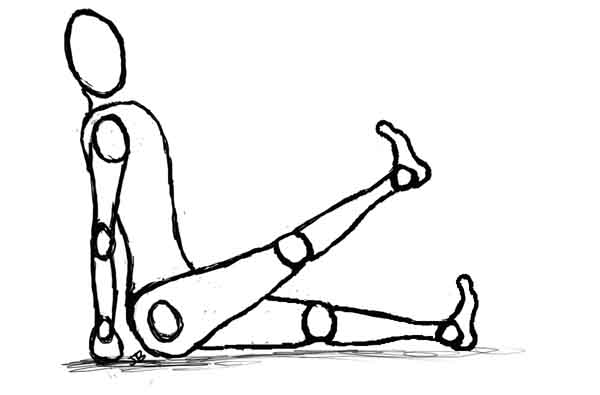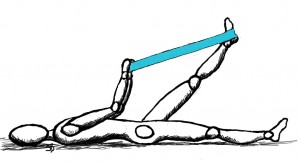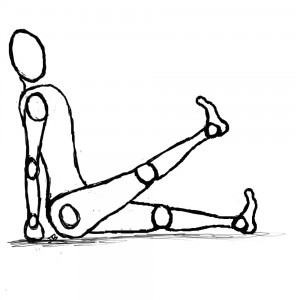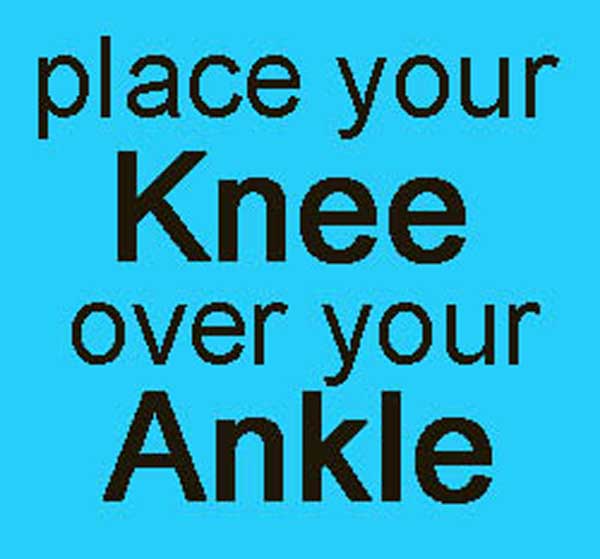Understanding Stretching – Reinforcing Hamstring Muscle Length – Part 3 of 4
Reinforcing Muscle Length
We have established that we can make a muscle longer through passive stretching, but if we want our lengthened muscle to stay longer then we are going to have to change the other muscles that interact with our target muscle. For our body to work well, there cannot be any ‘muscle slack’. We have to be able to move quickly when needed. To have one muscle in a group of muscles longer than normal is sort of like putting slack in a some rope attached to a series of pulleys. When we pull on a rope, all the pulleys must move, they shouldn’t just sit there and let us take up the slack first. That would be like us deciding to move our leg, but having to wait while our body reeled in the excess muscle length. That is not the way our ancestors escaped the cave bear. When we tell a muscle to act, it must act without delay – or else we become a cave bear snack.
All of us came from ancestors whose muscles did what they were supposed to do at a moments notice. Our body plan is set up this way and we must observe these physical realities. Thus, if we want to make a muscle longer, we must behave in ways that recondition the entire muscle group to our now longer muscle. If we have lengthened our target muscle, we must adapt the opposing muscle group. We must shorten our opposing muscle to take up the slack. We do this by contracting those opposing muscles enough times that they retain some muscle tone. Muscle tone means that even when we are not consciously tightening a muscle, some of the muscle fibers within that muscle are still contracting. Getting opposing muscle groups in tone is an easy process.
Resolving a Tight Hamstring
Let’s use the scenario of the tight hamstring. First we want to gently and reasonably passively stretch our tight hamstring, making sure we keep our lower back neutral and we don’t trigger the ‘watch out’ effect.
Reclined Passive Hamstring Stretch
- Recline on your back with your legs outstretched on the floor. Place a long strap around the heel of one leg.
- Keep your spine long with your lower back tilted slightly away from the floor.
- Using the strap, slowly lift your leg with the knee straight until you feel a very light amount of stretch.
- Make sure to lift the leg only as high as you can without changing your back.
- Hold your leg in the stretching position, breathing slowly and deeply for at least a minute.
- If done correctly, the stretch sensation will remain mild and maybe even begin to ease – a sure sign the muscle is lengthening. If you feel instead the stretch getting stronger, reduce the stretch sensation as your muscles are trying to fight you.
- Bend your knee and slowly return your leg to the floor.
- Repeat with the opposite leg.
Next we will set about to contract our quads so that we ‘take up the slack’ created by our longer hamstring. There are several exercises that would serve to shorten/contract our quadriceps and bring them into tone. One such exercise is to sit on the floor with good posture then slowly lift one straight leg at a time.
Seated Leg Lifts
- Sit with your legs outstretched straight in front and your spine long. It is okay to lean back in order to create your low back curve.
- Contract your thigh muscles.
- Keep your spine long with your chest lifted.
- Slowly lifting one leg as high as you can without changing your back.
- Slowly lower and then repeat with the other leg.
- Now rotate your legs inward and repeat the leg lifts.
- Now rotate your legs outward and repeat the leg lifts.
- Repeat to mild fatigue.
Now we have created a situation that encourages a more permanently long hamstring.
Of course, all of this has to be applied more than once in our lives, preferably at least once a week. It also is important for us to notice the postures of our body during our day since they are responsible for much of why our muscles might be tight in the first place. If we stop doing the postures that shorten our hamstrings; if we correctly stretch our tight hamstrings; if we contract, strengthen and shorten our opposing quadriceps group, then we will live in a body that has longer hamstrings.
Better yet if we also work our body in ways that make longer muscles a part of our regular workout. Better yet if we learn to apply what is known as active muscle stretching.
Coming up next – Active Muscle Stretching – part 4
Part 1
Part 2







